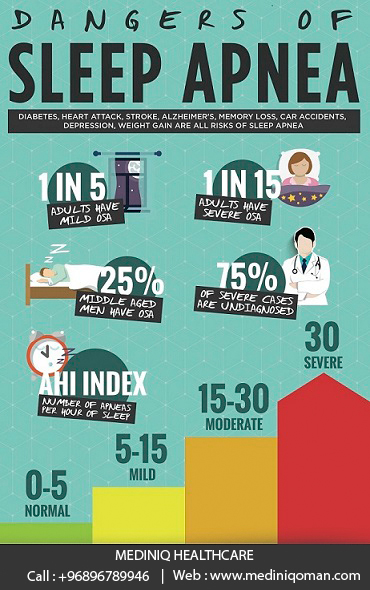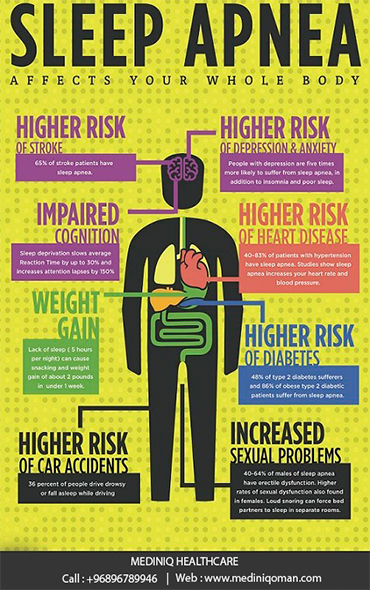- Contact us: +968-96789948
Mediniq is a leading respiratory care and sleep therapy specialist product supplier in Oman.

Obstructive Sleep Apnea (OSA) occurs when your airway temporarily collapses during sleep. You continue to make efforts to breath but are unable to move air in and out of your lungs because of the obstruction at the back of your throat. During the collapse, which can last from 10 seconds to over a minute, your breathing muscles continue to work with a progressive effort until you awaken and resume normal breathing. After a few breaths, your oxygen levels return to normal. You fall back to sleep and the airway obstruction occurs again. This cycle may continue throughout the night, disrupting your normal sleep pattern. As a result, you may complain of un-refreshing sleep and excessive daytime sleepiness.
For many sleep apnea patients, it is usually their partner or family members that suspect something is wrong. They may complain about their snoring and apparent struggle to breath at night. The typical sleep apnea patient may have the following symptoms:

Sleep apnea comes with an array of symptoms that can impact you. These symptoms can have an impact on your life as a whole and not just your ability to get a good night’s sleep. If you, or someone you love, experience the following symptoms it may be time to consult a doctor to see if you have sleep apnea:
The cycle of OSA starts with snoring and continues until the airway collapses or closes off. The person tries to breathe but is unable to get air into their lungs through the collapsed airway and an apnea (cessation of breathing) occurs. The brain realizes that it is not getting enough oxygen and fresh air so it wakes the person from a deep level, to a lighter level, of sleep. The airway then opens and normal breathing resumes. The person falls back into a deeper sleep, begins snoring again and the cycle repeats.
A number of medical treatments can be used to treat your sleep apnea and you should consult your doctor to find the treatment that will work best for you. What treatment should be used will depend on the type and severity of your sleep apnea.
Continuous Positive Airflow Pressure (CPAP) is a common treatment for sleep apnea, especially in moderate to severe cases of obstructive sleep apnea. The CPAP is a machine hooked up to a mask that provides a consistent stream of airflow that keeps your airways open while you sleep and ensures you are getting enough oxygen.
It is important that your CPAP machine is correctly set for your comfort. If it is incorrectly set, you may experience some bloating or discomfort wearing the mask. Some people have reported having headaches, dry mouth, irritated skin on the face, or a dry or stuffy nose. If you are experiencing any of these effects, speak with your doctor about tuning the machine to reduce these discomforts.
This technology is being updated all the time so if you have tried this treatment in the past and was unsatisfied with it, consult with your doctor and our sleep experts about the new advancements that will increase your comfort.
There are three types of sleep apnea:
If you have obstructive sleep apnea, it is caused by the muscles of the your throat relaxing while sleep. When this occurs, the muscles provide less support to the tonsils, the uvula (the triangular piece of tissue that hangs from your soft palate), and the side walls of the throat. When these areas get less support, it narrows your airway and you can’t get an adequate breath in.
If you have central sleep apnea, your brain is not sending the correct signals to the muscles that control your breathing. This causes you to have shallow breathing or to stop breathing for intervals of time. This type of apnea is more common after a stroke, with heart disease, or with narcotic or sedative use. Complex sleep apnea is a combination of the obstructive and central forms.